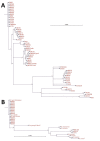Rickettsial Illnesses as Important Causes of Febrile Illness in Chittagong, Bangladesh
- PMID: 29553921
- PMCID: PMC5875266
- DOI: 10.3201/eid2404.170190
Rickettsial Illnesses as Important Causes of Febrile Illness in Chittagong, Bangladesh
Abstract
We conducted a yearlong prospective study of febrile patients admitted to a tertiary referral hospital in Chittagong, Bangladesh, to assess the proportion of patients with rickettsial illnesses and identify the causative pathogens, strain genotypes, and associated seasonality patterns. We diagnosed scrub typhus in 16.8% (70/416) and murine typhus in 5.8% (24/416) of patients; 2 patients had infections attributable to undifferentiated Rickettsia spp. and 2 had DNA sequence-confirmed R. felis infection. Orientia tsutsugamushi genotypes included Karp, Gilliam, Kato, and TA763-like strains, with a prominence of Karp-like strains. Scrub typhus admissions peaked in a biphasic pattern before and after the rainy season, whereas murine typhus more frequently occurred before the rainy season. Death occurred in 4% (18/416) of cases; case-fatality rates were 4% each for scrub typhus (3/70) and murine typhus (1/28). Overall, 23.1% (96/416) of patients had evidence of treatable rickettsial illnesses, providing important evidence toward optimizing empirical treatment strategies.
Keywords: Bangladesh; Orientia tsutsugamushi; Rickettsia felis; Rickettsia typhi; bacteria; murine typhus; rickettsia; rickettsial disease; scrub typhus; undifferentiated febrile illness; vector-borne diseases.
Figures



Similar articles
-
High seroprevalence of antibodies against spotted fever and scrub typhus bacteria in patients with febrile Illness, Kenya.Emerg Infect Dis. 2015 Apr;21(4):688-91. doi: 10.3201/eid2104.141387. Emerg Infect Dis. 2015. PMID: 25811219 Free PMC article.
-
Concurrent Infection of Orientia Tsutsugamushi with Rickettsia spp. Including Rickettsia felis in North Central Bangladesh.Mymensingh Med J. 2022 Apr;31(2):350-354. Mymensingh Med J. 2022. PMID: 35383749
-
Q Fever, Scrub Typhus, and Rickettsial Diseases in Children, Kenya, 2011-2012.Emerg Infect Dis. 2016 May;22(5):883-6. doi: 10.3201/eid2205.150953. Emerg Infect Dis. 2016. PMID: 27088502 Free PMC article.
-
State of the art of diagnosis of rickettsial diseases: the use of blood specimens for diagnosis of scrub typhus, spotted fever group rickettsiosis, and murine typhus.Curr Opin Infect Dis. 2016 Oct;29(5):433-9. doi: 10.1097/QCO.0000000000000298. Curr Opin Infect Dis. 2016. PMID: 27429138 Free PMC article. Review.
-
Rickettsial infections in Southeast Asia: implications for local populace and febrile returned travelers.Am J Trop Med Hyg. 2014 Sep;91(3):451-60. doi: 10.4269/ajtmh.14-0191. Epub 2014 Jun 23. Am J Trop Med Hyg. 2014. PMID: 24957537 Free PMC article. Review.
Cited by
-
Molecular characterization of Orientia tsutsugamushi causing scrub typhus among febrile patients in north-central Bangladesh.New Microbes New Infect. 2019 Aug 27;32:100595. doi: 10.1016/j.nmni.2019.100595. eCollection 2019 Nov. New Microbes New Infect. 2019. PMID: 31641512 Free PMC article.
-
The temporal dynamics of humoral immunity to Rickettsia typhi infection in murine typhus patients.Clin Microbiol Infect. 2020 Jun;26(6):781.e9-781.e16. doi: 10.1016/j.cmi.2019.10.022. Epub 2019 Oct 31. Clin Microbiol Infect. 2020. PMID: 31678231 Free PMC article. Clinical Trial.
-
Epidemiology, Risk Factors and Seasonal Variation of Scrub Typhus Fever in Central Nepal.Trop Med Infect Dis. 2019 Feb 2;4(1):27. doi: 10.3390/tropicalmed4010027. Trop Med Infect Dis. 2019. PMID: 30717408 Free PMC article.
-
Outbreak prone communicable diseases of public health importance in the northern districts of West Bengal - Current status & the way forward.Indian J Med Res. 2021 Mar;153(3):358-366. doi: 10.4103/ijmr.IJMR_607_21. Indian J Med Res. 2021. PMID: 33906999 Free PMC article. Review.
-
Diagnostic Accuracy of the InBios Scrub Typhus Detect™ ELISA for the Detection of IgM Antibodies in Chittagong, Bangladesh.Trop Med Infect Dis. 2018 Sep 1;3(3):95. doi: 10.3390/tropicalmed3030095. Trop Med Infect Dis. 2018. PMID: 30274491 Free PMC article.
References
-
- Paris DH, Day NPJ. Tropical rickettsial infections. In: Farrar J, Hotez PJ, Junghanss T, Kang G, Lalloo D, White NJ, editors. Manson’s tropical diseases, 23 ed. Aalborg (Denmark): Elsevier Ltd.; 2013. p. 273–91.
Publication types
MeSH terms
Grants and funding
LinkOut - more resources
Full Text Sources
Other Literature Sources
Medical
Miscellaneous

